Gharial Crocodile
- March 5, 2024
- 0 comment
The Gharial Crocodile, scientifically known as Gavialis gangeticus, is a captivating reptile native to the Indian subcontinent. What sets this species apart is its unmistakable long, slender snout, making up a significant portion of its body. Unlike other crocodiles, the Gharial’s jaw structure is finely tuned for catching fish, with over 100 interlocking teeth ensuring a secure grip on slippery prey. These crocodiles are predominantly found in the freshwater habitats of rivers like the Ganges, Brahmaputra, and Mahanadi, along with lakes and marshes adjacent to these river systems.

Sadly, despite once being widespread throughout their range, Gharial populations have sharply declined due to habitat loss, pollution, and human activities. As a result, they are now critically endangered, with conservation efforts focusing on habitat restoration, captive breeding, and raising awareness about the importance of preserving these unique reptiles.
| Specification | Description |
|---|---|
| Scientific Name | Gavialis gangeticus |
| Common Name | Gharial Crocodile |
| Habitat | Freshwater rivers, lakes, and marshes of the Indian subcontinent |
| Physical Characteristics | Long, slender snout; raised dorsal ridge; specialized jaw structure with over 100 interlocking teeth |
| Diet | Primarily fish, with fish making up nearly 90% of their diet |
| Distribution | Found in India, Nepal, Bhutan, Bangladesh, and Pakistan |
| Conservation Status | Critically endangered due to habitat loss, pollution, and human activities |
| Conservation Efforts | Habitat restoration, captive breeding programs, community-based conservation initiatives |
The Enigmatic Crocodilian
If you’ve ever heard of the Gharial, you might be familiar with its distinct appearance and mysterious nature. This fascinating creature is one of the most unique members of the crocodilian family, boasting remarkable physical characteristics and ecological adaptations that set it apart from other reptiles.
Physical Characteristics
Long, Narrow Snout
The Gharial Crocodile is characterized by its exceptionally long and narrow snout, which sets it apart from other crocodilian species. This elongated snout allows the Gharial to swiftly slice through water with minimal resistance, making it well-adapted for its aquatic lifestyle.
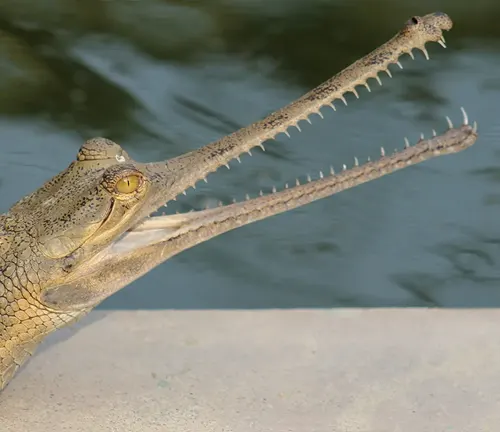
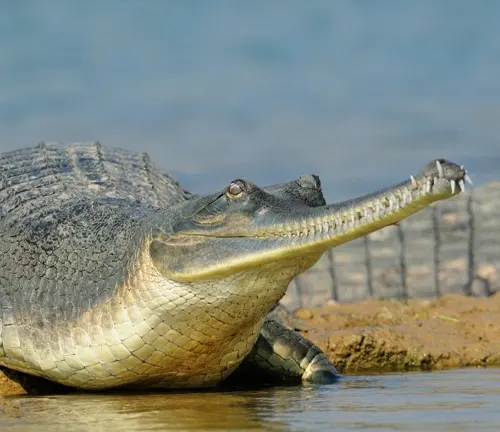
Unique Jaw Structure
One of the most distinctive features of the Gharial is its specialized jaw structure. It has a thin, elongated jaw with over 100 interlocking teeth, which are perfectly adapted for grasping and holding onto slippery prey, such as fish. Unlike other crocodiles, the Gharial’s jaw is not suited for crushing or tearing flesh, reflecting its primarily piscivorous diet.
Distinctive Body Features
In addition to its long snout and unique jaw structure, the Gharial exhibits other distinctive body features. These include a streamlined body shape with a raised ridge along its back, resembling a sail. This dorsal ridge, which is more prominent in males, is believed to play a role in courtship displays and thermoregulation.
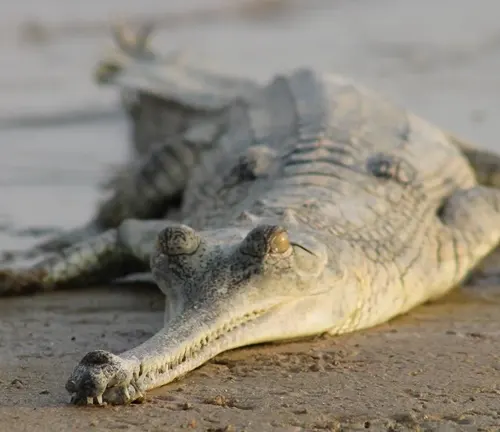
Habitat and Distribution
Native Regions
The native regions of the Gharial Crocodile encompass the freshwater habitats of the Indian subcontinent. This includes countries such as India, Nepal, Bhutan, Bangladesh, and Pakistan. Within these countries, Gharials inhabit rivers, tributaries, lakes, and marshes, particularly those connected to major river systems like the Ganges, Brahmaputra, and Mahanadi.

Preferred Habitats
Gharials prefer habitats with slow-moving or stagnant freshwater, characterized by deep pools, sandy riverbanks, and ample vegetation. They are commonly found in riverine environments with clear water and abundant fish populations, which serve as their primary food source. Gharials also utilize lakes, marshes, and wetlands adjacent to rivers for basking and nesting.

Conservation Status
The conservation status of Gharials is critically endangered. Habitat loss, pollution, illegal fishing practices, and incidental capture in fishing nets pose significant threats to their survival. The construction of dams and barrages has also fragmented their riverine habitats, further exacerbating their decline. Conservation efforts are underway to protect and restore Gharial habitats, establish captive breeding programs, and raise awareness about the importance of conserving this iconic species.
Feeding Habits
Diet Composition
The diet of the Gharial Crocodile primarily consists of fish, with fish making up nearly 90% of their overall diet. They are highly specialized piscivores, meaning they are adapted to catch and consume fish as their main source of nutrition. While they primarily target small to medium-sized fish, Gharials have been known to consume a variety of aquatic prey, including crustaceans, amphibians, and occasionally small mammals or birds.
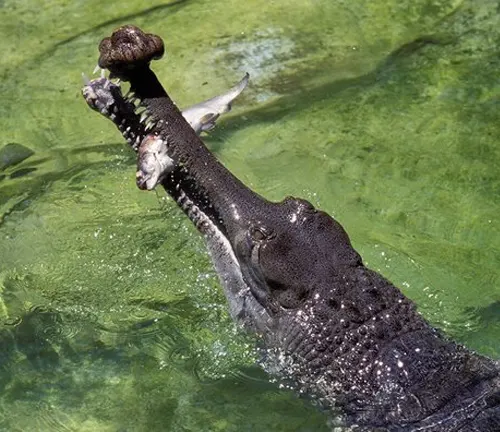
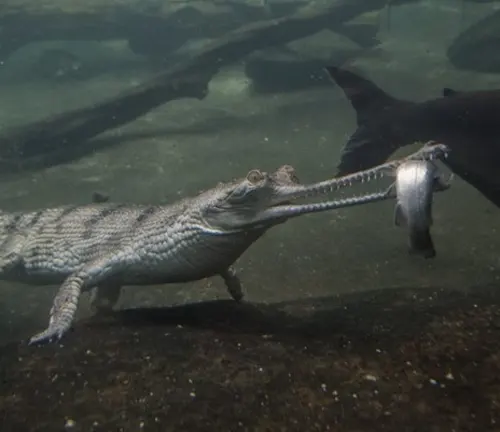
Hunting Strategies
Gharials employ stealthy hunting strategies to capture their prey underwater. They use their long, slender snouts and specialized jaw structure to swiftly navigate through water and snatch fish with precision. Gharials are known for their patient approach, silently gliding through the water before lunging forward to grasp their prey. Their streamlined bodies and powerful tails enable them to move with agility, making them efficient hunters in their aquatic environment. Once they catch their prey, Gharials swallow it whole, as their jaws are not well-suited for tearing or chewing flesh.
Reproduction
Breeding Behavior
Gharials exhibit fascinating breeding behaviors, particularly during the mating season. Male Gharials establish territories along riverbanks and engage in elaborate courtship displays to attract females. These displays often involve vocalizations, head-slapping, and bubble blowing, with dominant males competing for mating opportunities. Once a female selects a mate, they engage in mating rituals both in and out of the water, culminating in successful copulation.


Nesting Habits
After mating, female Gharials seek out suitable nesting sites along sandy riverbanks or in nearby marshes. They excavate nest pits using their hind legs and lay clutches of eggs, typically ranging from 20 to 50 eggs per nest. The female carefully covers the eggs with sand and vegetation to protect them from predators and environmental conditions. The incubation period lasts around 70 to 90 days, during which the female guards the nest and periodically checks the temperature to ensure proper development.
Parental Care
Once the eggs hatch, typically during the monsoon season when river levels rise, the female assists her hatchlings in reaching the water. She may gently carry them in her mouth or nudge them towards the riverbank, providing protection and guidance during this critical stage of their development. However, unlike some other crocodilian species, Gharials do not exhibit extensive parental care beyond this initial phase. The hatchlings are left to fend for themselves in the water, where they must quickly learn to hunt and avoid predators to survive.
Threats and Conservation Efforts
Human Impact
Human activities have had a significant impact on Gharial populations and their habitats. Habitat loss and degradation due to deforestation, dam construction, and urbanization have resulted in the loss of critical freshwater habitats for Gharials. Pollution from industrial runoff, agricultural chemicals, and plastic waste further threatens water quality and the availability of prey. Additionally, illegal fishing practices and accidental entanglement in fishing nets have led to injury and mortality among Gharials. Human-wildlife conflicts also pose a risk to Gharials, as they may be hunted or harmed due to misconceptions or fear.
Conservation Initiatives
Recognizing the urgent need to protect Gharial populations, conservation initiatives have been implemented to address the threats they face. These initiatives include habitat restoration projects aimed at preserving and restoring critical riverine habitats, such as reforestation efforts along riverbanks and wetland conservation measures. Captive breeding programs have been established to breed and reintroduce Gharials into the wild, bolstering dwindling populations and genetic diversity. Additionally, community-based conservation initiatives engage local communities in Gharial conservation efforts through education, outreach, and sustainable resource management practices. Collaboration between government agencies, non-profit organizations, and local communities is essential for the success of these conservation initiatives in safeguarding the future of Gharials and their freshwater ecosystems.
Different Species
Indian Gharial
(Gavialis gangeticus gangeticus)
This is the most well-known and widely recognized subspecies of the Gharial. It is found primarily in the rivers of northern India, particularly in the Ganges and Brahmaputra river systems.

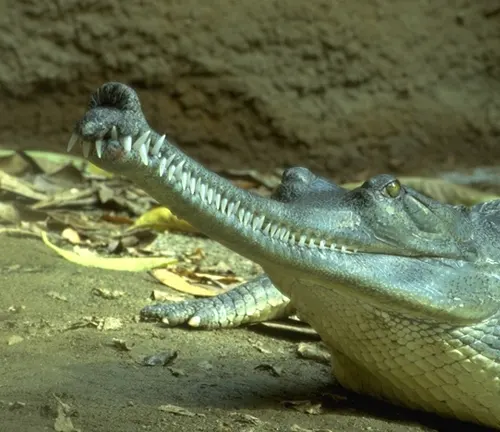
Nepalese Gharial
(Gavialis gangeticus gangeticus)
Similar to the Indian Gharial, the Nepalese population inhabits the rivers and tributaries of Nepal. However, due to its smaller population size and limited habitat, it is considered a distinct population within the same subspecies.
Bengal Gharial
(Gavialis gangeticus bengawanicus)
This subspecies of Gharial is found in the rivers of Bangladesh, particularly in the Brahmaputra and Meghna river systems. It exhibits similar physical characteristics to the Indian Gharial but may have slight variations due to its specific habitat.
Pakistani Gharial
(Gavialis gangeticus ssp.)
Although less studied than its Indian and Nepalese counterparts, the Pakistani population of Gharials inhabits the rivers of Pakistan, including the Indus River system. Research on this population is ongoing to better understand its genetics and ecological needs.

Frequently Asked Question (FAQs)
- What distinguishes the Gharial from other crocodile species?
The Gharial is characterized by its long, slender snout and specialized jaw structure, which are adapted for catching fish. - How many Gharials are estimated to remain in the wild?
Current estimates suggest that fewer than 300 Gharials exist in the wild, making them critically endangered. - What are the main threats to Gharial populations?
Habitat loss, pollution, illegal fishing practices, and accidental entanglement in fishing nets are the primary threats to Gharial populations. - Where can I see Gharials in the wild?
Gharials can be found in freshwater habitats across the Indian subcontinent, particularly in the rivers of India, Nepal, Bhutan, Bangladesh, and Pakistan. - Do Gharials play a role in their ecosystems?
Yes, Gharials play a crucial role in maintaining the balance of freshwater ecosystems by controlling fish populations and serving as indicators of ecosystem health. - How do Gharials communicate with each other?
Gharials communicate through various vocalizations, head movements, and body postures, especially during the breeding season. - What is the breeding season for Gharials?
Gharials typically breed during the dry season, which varies depending on their geographic location within their range. - How long does it take for Gharial eggs to hatch?
The incubation period for Gharial eggs ranges from 70 to 90 days, after which the hatchlings emerge from their nests. - Do Gharials have any natural predators?
While adult Gharials have few natural predators, their eggs and hatchlings may be preyed upon by other reptiles, birds, and mammals. - Are there any ongoing conservation projects specifically focused on Gharials?
Yes, several conservation organizations and government agencies are actively involved in projects aimed at protecting and restoring Gharial habitats and populations.


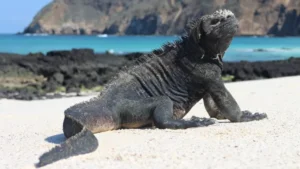
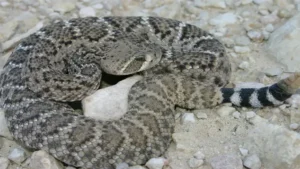

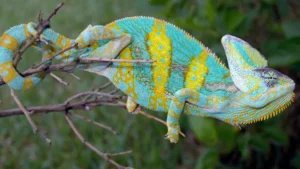



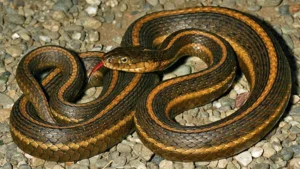
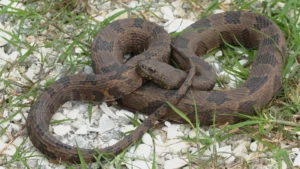
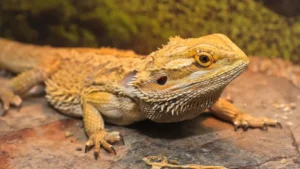
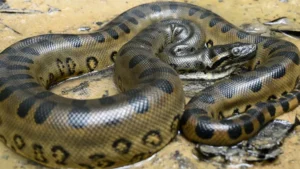

Leave your comment